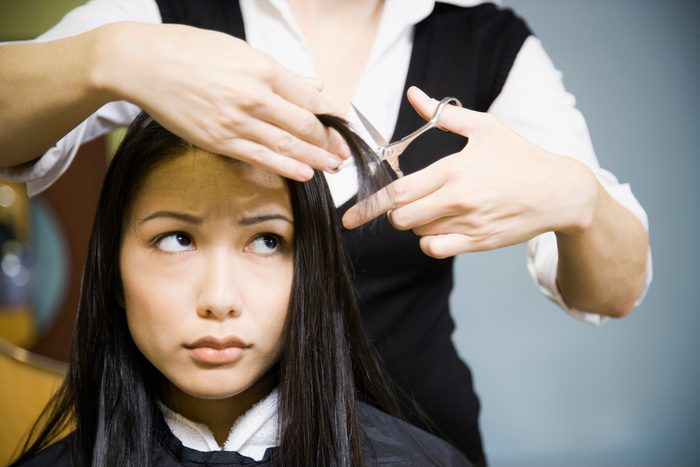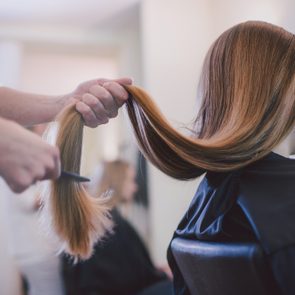So You Got a Bad Haircut—Here’s What to Say and How to Fix It
Updated: Nov. 23, 2023

Whether you’re getting a cut or a color, a trip to the salon can be a transformative experience. When you like what your hairstylist does, it can make you feel refreshed and even boost your confidence. From suggesting hairstyles that make you look younger to finding the best hair color for your skin tone, there are tons of things a stylist can do to make you feel good. The flip side of that coin? Sometimes a bad haircut happens.
We’ve all been there, and as you probably know all too well, it is the absolute worst. After all, you’ll likely have to live with your bad haircut for a while—plus, things can get super awkward with your hairdresser after the big reveal. Looking for red flags at hair salons can help you avoid working with a stylist who isn’t up to snuff, but even an excellent stylist can make a misstep.
So what should you do if you get a bad haircut? Hint: One of the polite habits hairdressers dislike is clients staying quiet when they’re unhappy. Here’s everything you need to know about dealing with this situation, according to stylists, including how to speak up and how much to tip your hairdresser when you don’t like the results.
Get Reader’s Digest’s Read Up newsletter for more etiquette tips, humor, cleaning, travel, tech and fun facts all week long.
What should you do if you get a bad haircut?
It may be easier said than done, but don’t panic. First, assess what it is you don’t like about your new ‘do. If you got a cut, is it the actual cut, or is your hair styled in a way you don’t love? For example, maybe your stylist gave you pin-straight strands when you prefer bouncy waves.
If it’s a styling mistake, you can fix that when you do your hair on your own. “If it’s an issue with the actual cut or color, don’t hesitate to speak up,” says Shantise Michelle, a celebrity hairstylist in New Jersey. “Constructive criticism is always helpful.” Even better? If you can speak up during the cutting (or blow-drying) process.
When you’re at the salon, pay attention to what your stylist is doing instead of zoning out on your phone. If it looks like they are taking off too much length or adding more layers than you care for, say something. “It’s better to speak up right away,” says Michelle. “This can help prevent a bad haircut. Plus, it allows your stylist to do something before it’s too late.”
What should you say to your hairdresser?
If you weren’t able to speak up during your cut or color and you’re left with a hairy situation, you should definitely say something after the fact. One of the biggest hairstylist secrets? They really want to know what you think of their work so they can keep you as a client and give you what you want the next time around—or fix things before you leave the salon. Of course, saying something is easier said than done. Here are some pointers to get you through that uncomfortable moment.
Be honest but kind
Feel too awkward saying you hate your hair? More gentle language may help you express yourself. “Tell your stylist you are unsure how you feel about the cut,” says Cody Renegar, a celebrity hairstylist in Los Angeles. This gives them some intel that all is not well, and they’ll likely ask some clarifying questions that will help you express your true feelings.
And remember to be kind. Chances are the stylist didn’t want you to hate your hair—and they probably put a good deal of time and energy into it. “Rather than criticize the stylist, focus on talking about what you don’t like about the cut or color,” says Michelle. It will be much more productive to focus on your hair, rather than their skills.
Get specific
I hate it. This is so not me. Who would ever want their hair to look like this?! While those may be the thoughts running through your mind, they aren’t super helpful as information for your stylist. Instead, try to be as specific as you can. “Be detailed about what you are unhappy with,” says Renegar. “For example, ‘The tone is a little ashy for me,’ or ‘It’s too short to style it the way I imagined.'” This will help the stylist understand exactly how they missed the mark, and they’ll be able to make suggestions that could possibly improve how you feel about your new ‘do. If it is a simple styling issue, they can help you put your mind at ease and also tweak it to be more you.
Make suggestions if you can
After getting specific about what it is you don’t like, try making suggestions on what could improve it. “Give your stylist a chance to fix it,” says Renegar. Obviously, if they took off too much length, there’s not much you will be able to do. But if your hair is feeling too heavy or bulky, see if they could add some face-framing layers. If your highlights look too brassy, ask if a toner or using purple shampoo would help. No one expects you to have the full answer, but making a few suggestions can get a conversation going and help you and your stylist work together to figure out a path forward.
How can you fix a bad haircut?
If you’ve left the salon and you still aren’t happy, go home and play around with styling possibilities. Try blowing it out how you normally would to see if that helps things. If not, “try changing your part,” suggests Renegar. “The placement of your part can make a huge difference.”
You can also switch things up on your end. If you don’t love your layers, straightening your hair will draw attention to them. A curling iron, on the other hand, can give you loose waves that diffuse those layers. The key is to select a curling iron that’s at least one-inch in diameter—anything smaller will give you tight curls over loose waves.
Another option: hair accessories. Let’s say the stylist cut your bangs too short. Pushing them back with an on-trend knotted headband will give you a cute look while your bangs grow out a bit. Hats, scarves and clips can also help, depending on the situation, as long as they’re stylish and in line with your look. In other words, they should just look like awesome accessories, not things meant to camouflage a mistake.
If your color is the problem, you may need to give it a beat before you make any changes. “You’ll have to wait at least two weeks, but it is even better to wait four to six weeks to minimize damage,” says Renegar.
Should you tip your hairdresser after a bad haircut?
The last thing you want to do at the salon is break etiquette rules. But if you get a bad haircut, do you really have to tip? “Tipping is always optional and not expected if you are unhappy,” says Renegar. That said, before you make a decision, really think about the reason behind your bad haircut.
For example, if your stylist didn’t listen to you and just did their own thing, a tip is not in order. But if they tried to warn you against bangs and you still pushed them to do it and now you don’t like the result? You should probably tip. “Tipping shows gratitude for a stylist’s time and effort, regardless of the outcome,” says Michelle. You should also consider tipping if the stylist did their best to make adjustments after you vocalized your disappointment.
How can you minimize the chances of getting a bad haircut in the future?
It’s all about communicating. If you’re worried that talking too much during the consultation phase of a cut is an etiquette mistake, don’t be! The right time to get on the same page about your desired outcome is before a stylist starts working on your hair.
“Clearly communicate your vision with your stylist—detailing what you do want, and also what you don’t,” says Michelle. “Visuals can be really helpful too. Bring in photos of styles you like.” Don’t know exactly what you want? That’s OK too. If you want to talk with your stylist about hairstyles for women over 40, bring in a few pictures of ‘dos you like. Then ask their opinion, and spend time talking about the pros and cons of each.
If you don’t understand something your stylist is describing, ask if they have a photo they can show you as an example. Same goes if they are using hairstyle terms you don’t know—simply ask them to explain what they’re talking about. “Effective communication will go a long way in ensuring your stylist delivers the desired outcome,” says Michelle. And that’s good for you and your hairstylist.
Sources:
- Shantise Michelle, a celebrity hairstylist in New Jersey
- Cody Renegar, a celebrity hairstylist in Los Angeles






















